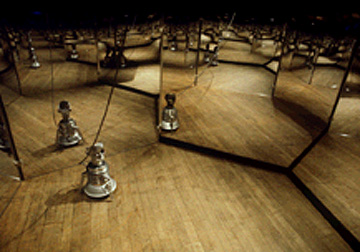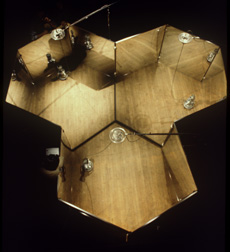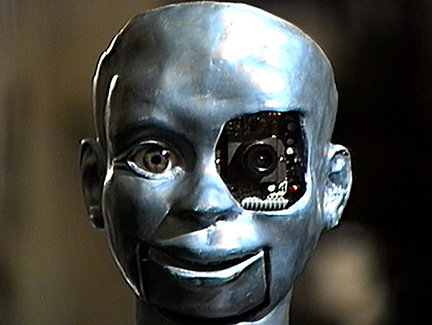



where I can see my house from here so we are
1993-95
What is there to say?
Does it make a difference if you are not seen, but rather a projection that sees and speaks and hears in your place?
Is the 'I' saying 'Me' to 'It-You' (or its reflection)?
Is it that the one who stands in your place is not free to go where they wish, or that even as you move them "freely" in their mirrored infinity theater that there are borders?
Is it that they can see their wires but know not where they lead?
Is it that in the space of the art exhibition there is also a meeting of those who see but are not seen and those who learn to play the game with their projections?
I learned in 1991 that the Mbone had been invented, making it possible to transmit "real-time" video and audio over the Internet. A networked metaphor would seem to offer a new genre of complexity - were it not for the fact that "here" and "there", "I" and "you" and "mine" and "yours" have always been bones in the skeleton of our sense-selves and in our ideologies. I found myself thinking: "Maybe creating a telematic videoconference among three ventriloquist dolls would be enough to ask the guest ventriloquists if having a voice, having a 'body' in this tele-space, could create new ground for discovering the metaphors of long-distance impersonation? ..."
In one exhibition there is a constructed labyrinth. The walls are mirrored. Inside of this space, there are three robot-puppet ventriloquist dolls. In three other locations are darkened spaces, each with a place to sit, a small table upon which sits a special controller-interface (an attaché case containing a joystick and a microphone), and upon the facing wall a large projected video image showing their robot's vision, effectively, computer controlled "video-telephones."
Each robot has a video camera for "sight", microphones for "hearing". Each robot is connected, remotely, to one of the other spaces (anywhere on the Internet Mbone). In these other locations, a viewer may see (via the video projection) and hear what the robot sees and hears, can maneuver it with a joystick, while the voice of the remote viewer is transmitted back to the robot, that speaks (like the doll of a ventriloquist) the words of that person. It is then possible for three people to communicate with each other in the hall-of- mirrors via their respectively controlled robots. Viewers in the public/gallery space with the robots can see over the walls, allowing them to talk with people at the connected distant locations via the robots.
Participants are inevitably pressed to regard these questions:
"Which one is me?"
"Am I talking to you or to myself?"
"Am I moving towards or away from the mirror?"
"What are the limits of this space?"
"Am I having any effect on what is happening?"
-kf 1995
exhibition history:
Mary Anthony Galleries, New York, "Synesthesia", March-May 1995
Interactive Media Festival, Los Angeles, June 1995
ACE Gallery, Los Angeles, 2005-2006
Ken Feingold | artworks | catalog | reference texts | contacts
copyright © 1998-2019 all rights reserved